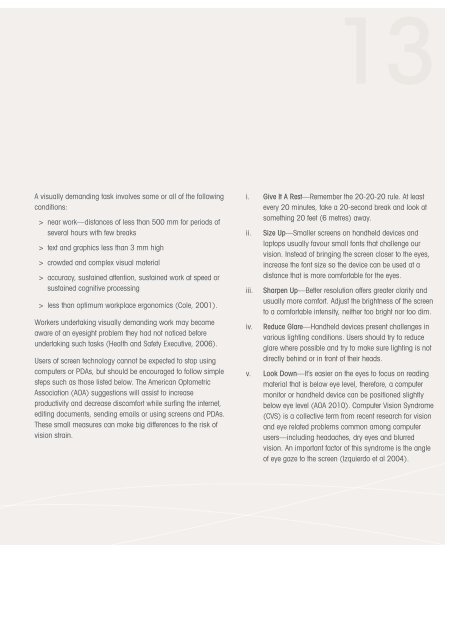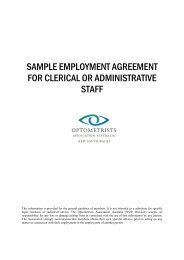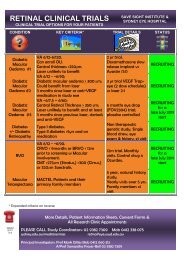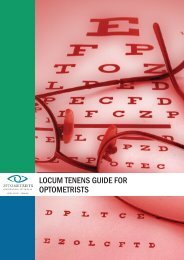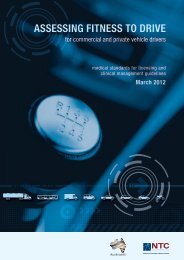Eye health in the workplace - a guide for PCBUs and ... - Comcare
Eye health in the workplace - a guide for PCBUs and ... - Comcare
Eye health in the workplace - a guide for PCBUs and ... - Comcare
You also want an ePaper? Increase the reach of your titles
YUMPU automatically turns print PDFs into web optimized ePapers that Google loves.
13<br />
A visually dem<strong>and</strong><strong>in</strong>g task <strong>in</strong>volves some or all of <strong>the</strong> follow<strong>in</strong>g<br />
conditions:<br />
> near work—distances of less than 500 mm <strong>for</strong> periods of<br />
several hours with few breaks<br />
> text <strong>and</strong> graphics less than 3 mm high<br />
> crowded <strong>and</strong> complex visual material<br />
> accuracy, susta<strong>in</strong>ed attention, susta<strong>in</strong>ed work at speed or<br />
susta<strong>in</strong>ed cognitive process<strong>in</strong>g<br />
> less than optimum <strong>workplace</strong> ergonomics (Cole, 2001).<br />
Workers undertak<strong>in</strong>g visually dem<strong>and</strong><strong>in</strong>g work may become<br />
aware of an eyesight problem <strong>the</strong>y had not noticed be<strong>for</strong>e<br />
undertak<strong>in</strong>g such tasks (Health <strong>and</strong> Safety Executive, 2006).<br />
Users of screen technology cannot be expected to stop us<strong>in</strong>g<br />
computers or PDAs, but should be encouraged to follow simple<br />
steps such as those listed below. The American Optometric<br />
Association (AOA) suggestions will assist to <strong>in</strong>crease<br />
productivity <strong>and</strong> decrease discom<strong>for</strong>t while surf<strong>in</strong>g <strong>the</strong> <strong>in</strong>ternet,<br />
edit<strong>in</strong>g documents, send<strong>in</strong>g emails or us<strong>in</strong>g screens <strong>and</strong> PDAs.<br />
These small measures can make big differences to <strong>the</strong> risk of<br />
vision stra<strong>in</strong>.<br />
i. Give It A Rest—Remember <strong>the</strong> 20-20-20 rule. At least<br />
every 20 m<strong>in</strong>utes, take a 20-second break <strong>and</strong> look at<br />
someth<strong>in</strong>g 20 feet (6 metres) away.<br />
ii.<br />
iii.<br />
iv.<br />
Size Up—Smaller screens on h<strong>and</strong>held devices <strong>and</strong><br />
laptops usually favour small fonts that challenge our<br />
vision. Instead of br<strong>in</strong>g<strong>in</strong>g <strong>the</strong> screen closer to <strong>the</strong> eyes,<br />
<strong>in</strong>crease <strong>the</strong> font size so <strong>the</strong> device can be used at a<br />
distance that is more com<strong>for</strong>table <strong>for</strong> <strong>the</strong> eyes.<br />
Sharpen Up—Better resolution offers greater clarity <strong>and</strong><br />
usually more com<strong>for</strong>t. Adjust <strong>the</strong> brightness of <strong>the</strong> screen<br />
to a com<strong>for</strong>table <strong>in</strong>tensity, nei<strong>the</strong>r too bright nor too dim.<br />
Reduce Glare—H<strong>and</strong>held devices present challenges <strong>in</strong><br />
various light<strong>in</strong>g conditions. Users should try to reduce<br />
glare where possible <strong>and</strong> try to make sure light<strong>in</strong>g is not<br />
directly beh<strong>in</strong>d or <strong>in</strong> front of <strong>the</strong>ir heads.<br />
v. Look Down—It’s easier on <strong>the</strong> eyes to focus on read<strong>in</strong>g<br />
material that is below eye level, <strong>the</strong>re<strong>for</strong>e, a computer<br />
monitor or h<strong>and</strong>held device can be positioned slightly<br />
below eye level (AOA 2010). Computer Vision Syndrome<br />
(CVS) is a collective term from recent research <strong>for</strong> vision<br />
<strong>and</strong> eye related problems common among computer<br />
users—<strong>in</strong>clud<strong>in</strong>g headaches, dry eyes <strong>and</strong> blurred<br />
vision. An important factor of this syndrome is <strong>the</strong> angle<br />
of eye gaze to <strong>the</strong> screen (Izquierdo et al 2004).


